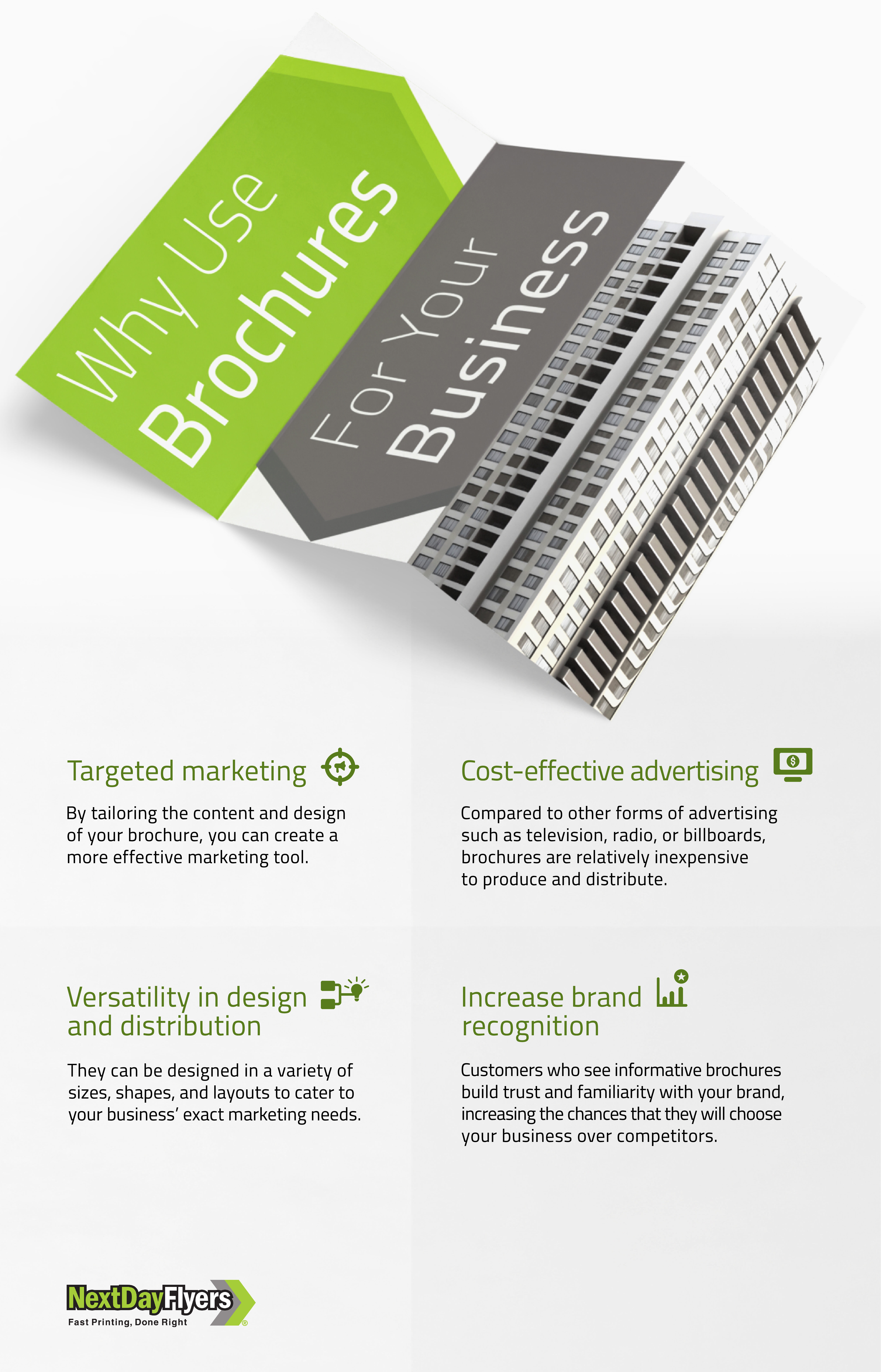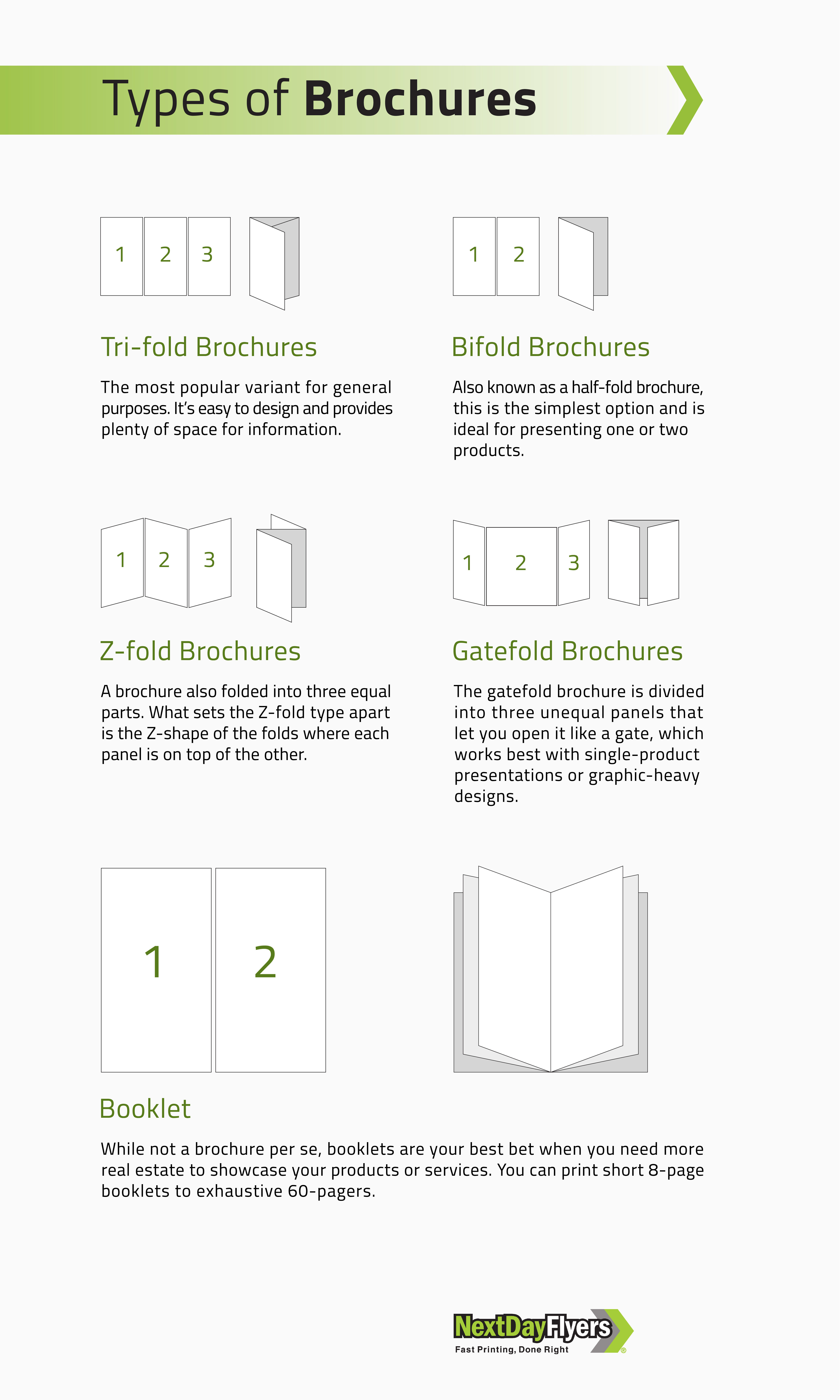Brochures: A Versatile Tool to Promote Your Business
Written By: Leslie Taylor | Article Date: May 15, 2023
Brochures can be a powerful marketing tool for businesses looking to promote their products or services. They provide a detailed, tangible, and cost-effective way to communicate with potential customers and establish credibility. In this guide, we go over the different kinds of brochures, effective brochure design, and pitfalls to avoid in creating your own.
Why Use Brochures for Your Business

Brochures are a time-tested marketing material. They are a quick and easy way to communicate brand information. Here are more of the big benefits of using brochures for your business:
- Targeted marketing. One of the main benefits of using brochures for your business is that they allow you to target specific audiences. By tailoring the content and design of your brochure, you can create a more effective marketing tool. For example, if you are promoting a new product, you can create a brochure that highlights the features and benefits that are most important to your target market. By focusing on the specific needs and interests of your audience, you can increase the chances that your brochure will be read and acted upon.
- Cost-effective advertising. Brochures are one of the most affordable ways to promote your business. Compared to other forms of advertising such as television, radio, or billboards, brochures are relatively inexpensive to produce and distribute. They can be printed in large quantities at a low cost, making them an affordable way to reach a broad audience.
- Versatility in design and distribution. Brochures are extremely versatile. They can be designed in a variety of sizes, shapes, and layouts to cater to your business’ exact marketing needs. Brochures can also be distributed in numerous ways, including direct mail, in-store displays, handouts at trade shows, and leave-behinds after meetings. Because of this versatility, you can design specific brochures to reach specific markets.
- Increased brand recognition. Brochures can help increase brand recognition and establish credibility for your business. A well-designed brochure can spell the difference between remaining unknown to getting recognized as an authority in your industry. Customers who see informative brochures build trust and familiarity with your brand, increasing the chances that they will choose your business over competitors. Additionally, brochures can be used to showcase your brand's unique value proposition, further differentiating your business from other brands.
Types of Brochures

- Tri-fold brochures – This type of brochure divides the sheet of paper into three equal parts where the right panel folds underneath the left panel. The tri-fold brochure is the most popular variant for general purposes since it’s easy to design and provides plenty of space for information.
- Bi-fold brochures – Also known as a half-fold brochure, this type of brochure is made up of a single sheet of paper folded in two. This is the simplest option and is ideal for presenting one or two products.
- Z-fold brochures – A brochure also folded into three equal parts. What sets the Z-fold type apart is the Z-shape of the folds where each panel is on top of the other.
- Gatefold brochures – The gatefold brochure is divided into three unequal panels, where the side panels measure half of the width of the central panel. This lets you open the brochure like a gate, which works best with single-product presentations or graphic-heavy designs.
- Booklets – While not a brochure per se, booklets are your best bet when you need more real estate to showcase your products or services. You can print short 8-page booklets to exhaustive 60-pagers.
Designing an Effective Brochure
- Defining the target audience. Before starting your brochure design, it is essential to define your target audience. This will help you determine the content, design, and messaging that will appeal to your potential customers. By understanding the needs and preferences of your target market, you can create a brochure that resonates with them and effectively communicates your brand's value proposition.
- Choosing the right format and size. The format and size of your brochure will depend on your marketing goals and the preferences of your target audience. For example, if you are distributing brochures at a trade show, a tri-fold brochure may be a more practical choice. For magazine inserts, a gatefold is a good way to showcase your brand. It is important to choose a format and size that is easy to distribute, visually appealing, and fits the content and messaging you want to convey.
- Creating a visually appealing layout. The layout of your brochure should be visually appealing and easy to read. The design should draw the reader's attention to the most important information and guide them through the content in a natural manner. Other design elements should blend harmoniously with the layout. The use of colors, images, and fonts can help to create an attractive and visually cohesive design.
- Writing compelling and concise content. The content of your brochure should be snappy and straight to the point. Use language that speaks directly to your target audience and highlights the benefits of your product or service. It is important to be clear and concise and avoid overloading the brochure with too much information. If need be, use bullet points and subheadings to break up the text and make it easier to read and digest.
- Incorporating branding and calls to action. Your brochure should incorporate your brand's visual identity and messaging to ensure consistency across all marketing channels. Including calls to action (CTA) helps encourage readers to take the next step, such as visiting your website or making a purchase. It is essential to make the CTA clear and prominent, so the reader knows what action to take.
Common Mistakes to Avoid When Designing and Distributing Brochures
- Overloading the brochure with too much information. When a brochure is cluttered with too much information, it can be overwhelming for readers and make it difficult for them to identify the key messages. This can lead to readers disregarding the brochure altogether. It is essential to focus on the most important information and present it in a clear and concise manner to avoid overwhelming the reader. Focus and simplify.
- Poor design and layout choices. A brochure with a poor layout and design can be unappealing and unprofessional, making it less likely to be read or kept by the reader. A well-designed brochure should be visually appealing and highlight key information effectively. Follow our design tips or commission a professional artist to help you with your brochure artwork.
- Inadequate distribution and targeting. Even if your brochure is well designed and contains the right information, it will not be effective if it does not reach the right people. It is important to have a clear distribution strategy. Make sure that you maximize every distribution channel available – direct mail, inserts, hands outs, and more. If the brochure is not distributed correctly, it can go unnoticed and fail to generate any new leads or sales.
- Using a poor printer. Your brochures are only as good as the paper it’s printed on. When customers substandard materials and sloppy printing, it’ll reflect badly on your brand. It is important to choose a high-quality printer that can produce a professional-looking brochure to ensure your brand is represented in the best possible light.
Brochures: A Boon for Businesses
Brochures are a powerful ally for businesses, big or small. They are cost-effective, versatile, and they help you build your brand for the better. Make sure to follow the tips we provided to maximize the effectiveness of your brochure marketing.
Ready to design your own custom brochures? Print with NextDayFlyers today.
Related Articles
8 Types of Brochure Folds and Their Applications - https://www.nextdayflyers.com/resources/printing/types-of-brochure-folds-and-their-applications.html
4 Layout Design Tips for Effective Postcards - https://www.nextdayflyers.com/resources/design/brochure-design-ideas.html
10 Tips for Creating your Brochure - https://www.nextdayflyers.com/blog/brochure_design/
Brochure Do’s and Don’ts - https://www.nextdayflyers.com/blog/brochure-dos-and-donts/
5 Tips for Creating a Travel Brochure - https://www.nextdayflyers.com/blog/5-tips-for-creating-a-travel-brochure/

